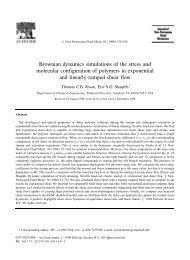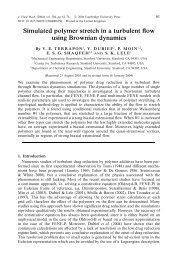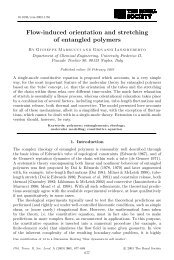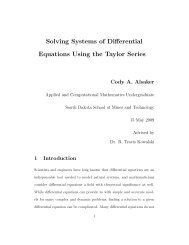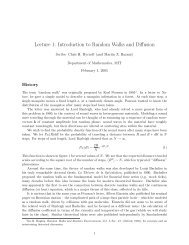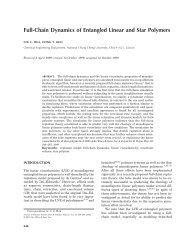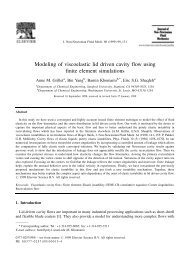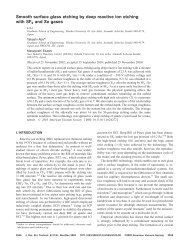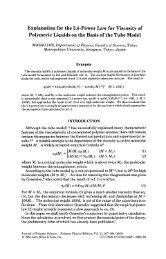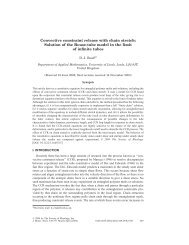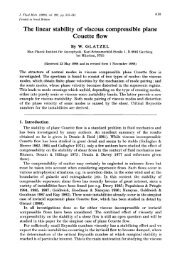A numerical study of the rheological properties of suspensions of ...
A numerical study of the rheological properties of suspensions of ...
A numerical study of the rheological properties of suspensions of ...
You also want an ePaper? Increase the reach of your titles
YUMPU automatically turns print PDFs into web optimized ePapers that Google loves.
164M. B. Mackaplow and E. S. G. Shaqfeh4. Theoretical predictionsThe most general form <strong>of</strong> (dp)) for an unbound fibre suspension can be written(Batchelor 1971)(0''') = [pUFIBRE ((pppp)- 6 (pp)/3) : (e)] x (I + O(AP21n(A))). (11)pFzBRE is a dimensional constant that is a function <strong>of</strong> <strong>the</strong> physical parameters in<strong>the</strong> suspension. The error term results from neglecting <strong>the</strong> effect <strong>of</strong> gradients in <strong>the</strong>undisturbed flow field along <strong>the</strong> fibre cross-sections. To present <strong>the</strong>oretical predictionsand our <strong>numerical</strong> results we will use a factor called Q, definedAs we shall show, examining Q facilitates determining <strong>the</strong> screening behaviour <strong>of</strong><strong>the</strong> suspension. Analysis <strong>of</strong> <strong>the</strong> equivalent versions <strong>of</strong> Q for heat and mass transferthrough fibre <strong>suspensions</strong> were successfully used in our previous <strong>study</strong> (Mackaplowet al. 1994) to determine suspension screening lengths. Using (4), (ll), and (12) wecan relate Q to moments <strong>of</strong> <strong>the</strong> fibre orientation distribution function, <strong>the</strong> externallyimposed flow field, and <strong>the</strong> <strong>numerical</strong>ly determined average particle stresslet :Q x [(~ppp) - 6 ( ~p) /31 : (e) = 3 (s)where we have used <strong>the</strong> non-dimensionalizations discussed in <strong>the</strong> previous section. Itis valid to use a single scalar constant, Q, to relate (S) and [(pppp) - 6 (pp) /3] : (e)since over <strong>the</strong> ensemble average, both <strong>of</strong> <strong>the</strong>se tensors will have <strong>the</strong> same tensorialform. We have verified this from our simulations.4.1. Dilute <strong>suspensions</strong>For dilute <strong>suspensions</strong>, pFIBRE (and <strong>the</strong>refore Q) is not a function <strong>of</strong> <strong>the</strong> particleorientation distribution, thus <strong>the</strong> entire effect <strong>of</strong> <strong>the</strong> particle orientation distributionon (dP)) is explicitly accounted for by <strong>the</strong> factor <strong>of</strong> (pppp)- 6 (pp)/3. In suchcases, <strong>the</strong> <strong>the</strong>oretical analysis <strong>of</strong> Batchelor (1970) based on slender-body <strong>the</strong>ory canbe used to show that1QDilute =2 [WA) + g(A)1where g(A) depends on <strong>the</strong> fibre shape. In particular, for spheroids he showed1QPpfi%icis =2 [ln(2A)- 1.51and for cylindersDilute 1[ln2A +0.640 1.659Qcy'inder =+-In 2A - 1.5 (In 2A)24.2. Corrections at O(n13)A dilute <strong>the</strong>ory for aligned <strong>suspensions</strong> that takes into account two-body interactionsis developed in <strong>the</strong> Appendix(13)



